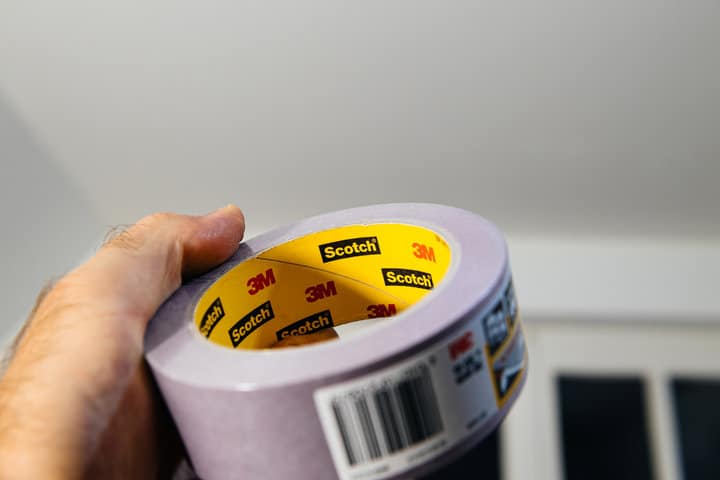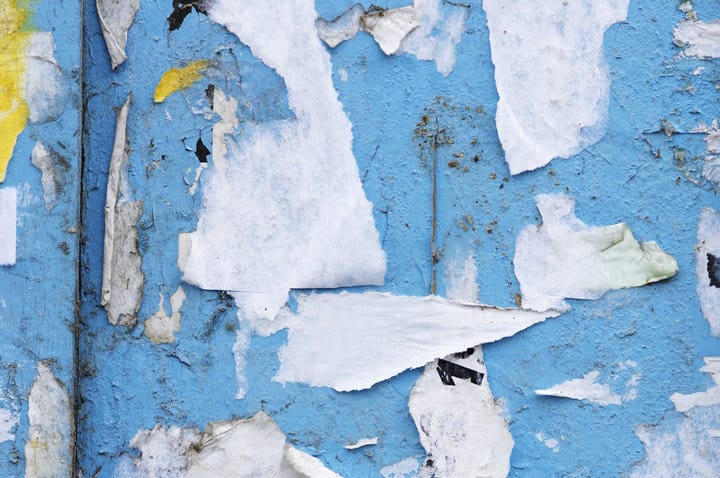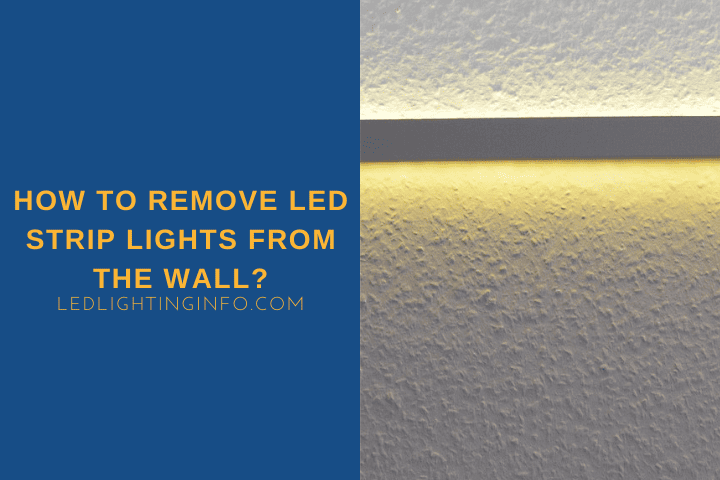Living in rented accommodation can be challenging to put your mark on a place without permanent damage to fixtures and fittings.
Nobody wants to lose money on their rented house and so LED light strips are often installed, since they can be taken down without causing damage, provided you’re careful.
So, want to know how to remove LED strip lights without incurring damage (and a fee)?
To remove LED light strips from walls:
- Weaken the adhesive – use lacquer thinner on latex paint, otherwise apply medium heat in short bursts (from a hairdryer or similar)
- Carefully work the LED light strip away from the wall, using something like an old credit card
- Use a clean cloth to remove any leftover residue
In this guide, I’ll cover:
- The types of adhesive materials used for LED strip lights
- The wall types most commonly damaged when you remove LED strip lights
- How to remove LED light strips from painted surfaces
- Removing sticky residue left behind by LED strips
Table of Contents
What Adhesive Material Is Used On LED Strip Lights?

Most renowned LED strips are backed with 3M adhesive regardless of the type or length. 3M is the gold standard for adhesives – it’s known as the most durable tape on the market. This is because it’s made from high-performance acrylic.
Put simply, this acrylic is multi-faceted. It behaves like both a very viscous liquid and an elastic solid. This property is known as viscoelasticity.
Viscoelasticity allows the 3M adhesives to glide into irregularities and unevenness on the surface it is applied to and form a very strong bond.
The result?
Durable LED strip lights can be fixed to a whole range of uneven surfaces.
But, of course, 3M adhesive isn’t completely faultless.
Over time, it loses stickiness and doesn’t adhere well to glossy or oily surfaces. In addition, it doesn’t respond well to humidity and moisture.
Plus, if you wanted to restick LED light strips on a wall, the adhesive only has one use, and so you’d need to replace it with new double sided tape.
So 3M has its fair share of problems.
These flaws encourage people to take matters into their own hands. That is, by applying their own adhesives to LED strip lights.
I’ve seen people adopt all sorts of methods – foam tape, double-sided glue dots, hot glue, and Gorilla tape, to name a few.
Command strips are one of the better choices – they make it easier to remove strip lights without damaging surfaces or your paint job.
Do LED Strip Lights Damage Walls?
The wall surfaces most often damaged when removing LED strips are:
- Bare drywall
- Painted walls
- Wallpapers
These are all fragile and can bond to the adhesive backing of your LED strip lights, causing damage when the strips are removed.
If your wall is tiled, wooden, or plastic, you should have no problems. The strips will be relatively easy to peel off and will cause no damage to the wall.
If anything, there may be some leftover adhesive residue that needs to be wiped clean.
Let’s face it, interior design is ever-changing. Your style and choices today are not the same as those of 1, 5, or even 10 years ago.
Does anyone else remember begging their parents to let them paint their bedroom a vivid color? How would you feel about that decision today?
You’ll probably want different LED strip lights in various positions for a while. So how easy is it to remove them once they have been stuck down?
The answer depends on the type of surface you adhere to.
Ultimately, wallpaper is just paper. If you apply strong adhesive to any paper, it will form a good bond. That’s why we use sellotape when wrapping presents!
But when it comes time to remove your LED strips, you’ll struggle to separate the two components. As a result, your wallpaper will likely tear, rip, or ripple.
This will be particularly frustrating if your wallpaper is patterned because any gaps will become extremely noticeable.
Similarly, you can’t just cover the wallpaper with paint to disguise the damage because the wallpaper is patterned.
How To Remove LED Strip Lights Without Peeling Paint?

How you remove LED strips from a painted wall depends on the type of paint used.
Removing An LED Light Strip From Latex Paint
Here’s how to remove LED strip lights from a latex paint job:
- Apply a lacquer thinner to the edges of the light strip
- Wait no more than five minutes, and then gently work the light strips away from the wall with a flat, dull object
- Clean the wall with a damp cloth using warm water, removing any leftover lacquer thinner
If your paint is latex-based, you can use a lacquer thinner to dissolve the adhesive without soaking into the paint.
You still need to work fairly quickly because that latex surface won’t hold up forever, and if the thinner gets into the paint, it’ll strip it from the walls.
Removing An LED Strip Light From Oil-Based Paint
Follow this easy step-by-step tutorial to remove your LED strips from oil-based paint while minimizing the risk of damage.
- Unplug your LEDs from their power source. Unless you know what you’re doing, you should never play with live electricity.
- You can use a hairdryer to heat the adhesive layer on the LEDs. This will make it softer and easier to pull off. Remember that with LEDs, excessive heat can speed up lumen degradation. So with that in mind, use the hair dryer for a maximum of two minutes.
- Starting at a corner or edge piece, insert a flat, dull object (such as razor scraper or credit card) under the LED strip.
- Wiggle the flat object to gently pry the LED strip from the wall.
- At the same time, use your other hand to slowly pull the LED strip off the surface. It’s important not to rush as you can rip off the paint.
- Continue until the LED strip is fully released. Remember to take your time.
Be careful with heat sources if you’re working with a painted wall. The paint should have cured fully, but blasting it with a hot hair dryer at point-blank range can weaken it.
If you’ve gone for the command strip option, you’ll want to carefully remove them by pulling on the tab in the indicated direction.
This will soften the sticking pad. Pull hard until it is completely free of the wall.
How To Get LED Strip Light Residue Off The Wall?

If there is a leftover tacky adhesive residue on the wall after removing your LED light strips, gently rub your thumb over it in a circular motion. Most of the time, gentle pressure is enough to collect the residue.
If this doesn’t work, apply a rubbing alcohol or WD-40 to a rag and rub back and forth until the adhesive is gone.
Try a rubbing alcohol first, because WD-40 – while highly effective – will leave behind a petroleum scent that can take a few days to clear.
FAQ
How To Remove Govee LED Strip Lights?
Govee LED lights use 3M adhesive to stick to walls, so it’s best to weaken the adhesive before attempting to remove an LED strip. Gentle use of a hairdryer in short bursts will work well, though you can also use lacquer thinner for Govee strips on a latex-based painted wall.
Will LED Strip Lights Rip The Paint?
LED strip lights can rip paint if you aren’t delicate in removing them. Both latex-based and oil-based paints can be damaged by the 3M adhesive strips used on light strips, as they bond to the paint stronger than the paint bonds to the walls in some instances.
You need to take steps to weaken the adhesive strip before you remove an LED light strip, using lacquer thinner for latex-based paint or a medium heat for oil-based paints. With care, more LED strips can leave paint intact once removed.
Final Words
It’s true, LED strip lights are a dream come true for renters and people who enjoy frequently changing their interior design choices.
Just make sure you follow the necessary steps to remove them carefully.
If you’re still unsure, you can always perform a patch test to see how the area is affected when removing LED strip lights. You need to do this before installing your strip lights, though.
Apply 3M adhesives to your home’s inconspicuous area, such as behind a cupboard or in a small nook.
Leave it for a day or two, and then pull it off to see if it causes any damage to your paint or wallpaper.
If you’re researching how to remove LED strip lights before you install them in your home, you’ll also need my guide on how to stick LED light strips to the walls.



Comments are closed.